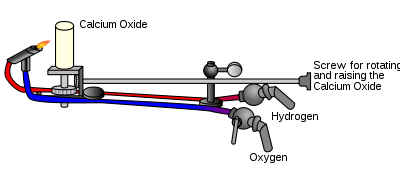- Limelight
-
El Limelight es un tipo de luz de escenario, que se utilizó en teatros y escenarios musicales en el siglo XIX. Funciona cuando una llama de oxihidrógeno se proyecta sobre una malla cilíndrica de cal viva (óxido de calcio),[1] que puede llegar a 2.572 ° C antes de fundirse, se genera una iluminación de alta intensidad. La luz se produce por una combinación de incandescencia y candoluminiscència. Aunque ya hace mucho tiempo que fue sustituido por el Arco eléctrico, el término ha sobrevivido en Inglaterra: cuando alguien es un personaje público famoso, se dice que está bajo el "Limelight".
Historia
El efecto fue descubierto en la década de 1820 por Goldsworthy Gurney,[2] sobre la base de su trabajo con la antorcha oxhídrica, "enacara que la invención se otorga normalmente a Robert Hare. En 1825 , un ingeniero escocés, Thomas Drummond (1797-1840), vio una demostración del efecto de Michael Faraday y se dio cuenta de que esta luz podía ser útil para la topografía. Drummond construyó una versión operativa en 1826, por ello es a veces conocido como Luz de Drummond en su honor.
El "Limelight" fue utilizado por primera vez en público en la Covent Garden Theatre en Londres en 1837 y gozó de un amplio uso en teatros de todo el mundo entre los años 1860 y 1870. Los Limelight ' fueron utilizados para poner de relieve los solistas, del mismo modo que hoy se hace con el moderno Followspot .[3] El ' Limelight fue reemplazado por el Arco eléctrico ya en el siglo XIX.
Véase también
- Candoluminiscència
- Luz de Klieg
- Lista de fuentes de luz
- Cronología de las tecnologías del hidrógeno
Referencias
- ↑ lime.html de la Semana - Lime
- ↑ [Limelight http://www.chem.leeds.ac.uk/delights/texts/Demonstration_19.htm - Universidad de Leeds] , el 18 de julio de 2008
- ↑ Plantilla:Citar libro
Categorías:- Luces
- Alumbrado
Wikimedia foundation. 2010.

